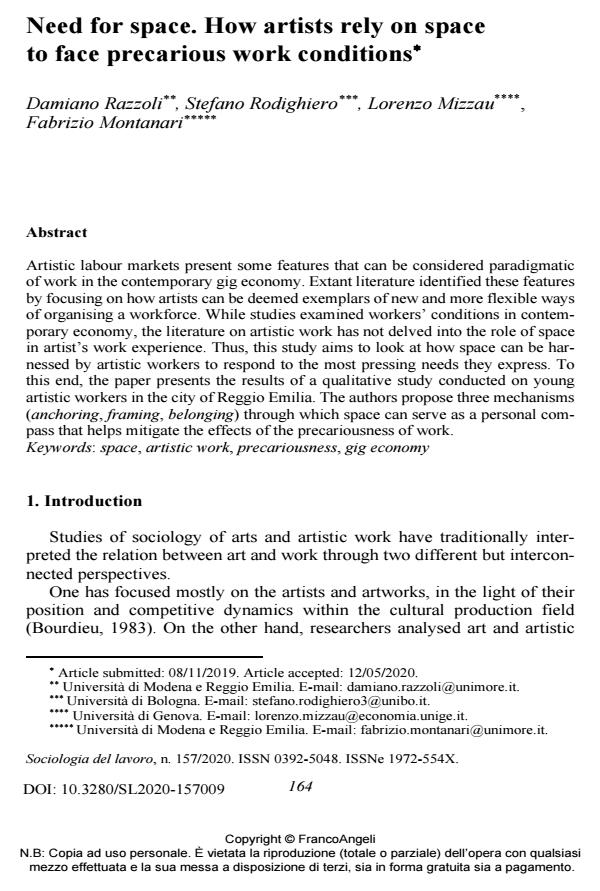Need for space. How artists rely on space to face precarious work conditions
Titolo Rivista SOCIOLOGIA DEL LAVORO
Autori/Curatori Damiano Razzoli, Stefano Rodighiero, Lorenzo Mizzau, Fabrizio Montanari
Anno di pubblicazione 2020 Fascicolo 2020/157
Lingua Inglese Numero pagine 22 P. 164-185 Dimensione file 294 KB
DOI 10.3280/SL2020-157009
Il DOI è il codice a barre della proprietà intellettuale: per saperne di più
clicca qui
Qui sotto puoi vedere in anteprima la prima pagina di questo articolo.
Se questo articolo ti interessa, lo puoi acquistare (e scaricare in formato pdf) seguendo le facili indicazioni per acquistare il download credit. Acquista Download Credits per scaricare questo Articolo in formato PDF

FrancoAngeli è membro della Publishers International Linking Association, Inc (PILA)associazione indipendente e non profit per facilitare (attraverso i servizi tecnologici implementati da CrossRef.org) l’accesso degli studiosi ai contenuti digitali nelle pubblicazioni professionali e scientifiche
Artistic labour markets present some features that can be considered paradigmatic of work in the contemporary gig economy. Extant literature identified these features by focusing on how artists can be deemed exemplars of new and more flexible ways of organising a workforce. While studies examined workers’ conditions in contemporary economy, the literature on artistic work has not delved into the role of space in artist’s work experience. Thus, this study aims to look at how space can be harnessed by artistic workers to respond to the most pressing needs they express. To this end, the paper presents the results of a qualitative study conducted on young artistic workers in the city of Reggio Emilia. The authors propose three mechanisms (anchoring, framing, belonging) through which space can serve as a personal compass that helps mitigate the effects of the precariousness of work.
Il mercato del lavoro artistico mostra alcuni tratti interpretabili come paradigmatici delle condizioni del lavoro contemporaneo. La letteratura esistente ha analizzato tali tratti con un focus su come gli artisti costituiscano un caso esemplare per capire i nuovi processi di organizzazione del lavoro. Si è posta attenzione sulle condizioni dei lavoratori nell’economia contemporanea ma, nell’indagare il lavoro artistico, il ruolo dello spazio rispetto all’esperienza lavorativa degli artisti non è stato approfondito. L’articolo esplora dunque come lo spazio possa essere sfruttato dagli artisti per sostenere il loro sviluppo professionale e occupazionale. A tal fine, illustra i risultati di una ricerca qualitativa su giovani lavoratori artistici della città di Reggio Emilia. Gli autori propongono tre meccanismi (anchoring, framing, belonging) attraverso i quali lo spazio aiuta a mitigare gli effetti della precarietà del lavoro.
Parole chiave:Spazio, lavoro artistico, precarietà, gig economy
Damiano Razzoli, Stefano Rodighiero, Lorenzo Mizzau, Fabrizio Montanari, Need for space. How artists rely on space to face precarious work conditions in "SOCIOLOGIA DEL LAVORO " 157/2020, pp 164-185, DOI: 10.3280/SL2020-157009